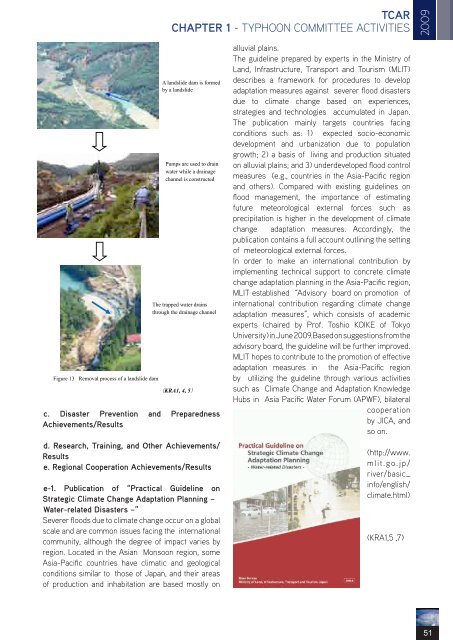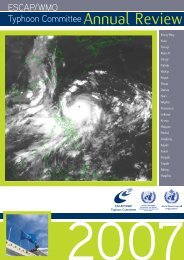TCAR - Typhoon Committee
TCAR - Typhoon Committee
TCAR - Typhoon Committee
You also want an ePaper? Increase the reach of your titles
YUMPU automatically turns print PDFs into web optimized ePapers that Google loves.
Figure 13 Removal process of a landslide dam<br />
<strong>TCAR</strong><br />
CHAPTER 1 - TYPHOON COMMITTEE ACTIVITIES<br />
A landslide dam is formed<br />
by a landslide<br />
Pumps are used to drain<br />
water while a drainage<br />
channel is constructed<br />
The trapped water drains<br />
through the drainage channel<br />
(KRA1, 4, 5)<br />
c. Disaster Prevention and Preparedness<br />
Achievements/Results<br />
d. Research, Training, and Other Achievements/<br />
Results<br />
e. Regional Cooperation Achievements/Results<br />
e-1. Publication of “Practical Guideline on<br />
Strategic Climate Change Adaptation Planning –<br />
Water-related Disasters –”<br />
Severer floods due to climate change occur on a global<br />
scale and are common issues facing the international<br />
community, although the degree of impact varies by<br />
region. Located in the Asian Monsoon region, some<br />
Asia-Pacific countries have climatic and geological<br />
conditions similar to those of Japan, and their areas<br />
of production and inhabitation are based mostly on<br />
alluvial plains.<br />
The guideline prepared by experts in the Ministry of<br />
Land, Infrastructure, Transport and Tourism (MLIT)<br />
describes a framework for procedures to develop<br />
adaptation measures against severer flood disasters<br />
due to climate change based on experiences,<br />
strategies and technologies accumulated in Japan.<br />
The publication mainly targets countries facing<br />
conditions such as: 1) expected socio-economic<br />
development and urbanization due to population<br />
growth; 2) a basis of living and production situated<br />
on alluvial plains; and 3) underdeveloped flood control<br />
measures (e.g., countries in the Asia-Pacific region<br />
and others). Compared with existing guidelines on<br />
flood management, the importance of estimating<br />
future meteorological external forces such as<br />
precipitation is higher in the development of climate<br />
change adaptation measures. Accordingly, the<br />
publication contains a full account outlining the setting<br />
of meteorological external forces.<br />
In order to make an international contribution by<br />
implementing technical support to concrete climate<br />
change adaptation planning in the Asia-Pacific region,<br />
MLIT established “Advisory board on promotion of<br />
international contribution regarding climate change<br />
adaptation measures”, which consists of academic<br />
experts (chaired by Prof. Toshio KOIKE of Tokyo<br />
University) in June 2009.Based on suggestions from the<br />
advisory board, the guideline will be further improved.<br />
MLIT hopes to contribute to the promotion of effective<br />
adaptation measures in the Asia-Pacific region<br />
by utilizing the guideline through various activities<br />
such as Climate Change and Adaptation Knowledge<br />
Hubs in Asia Pacific Water Forum (APWF), bilateral<br />
cooperation<br />
by JICA, and<br />
so on.<br />
(http://www.<br />
mlit.go.jp/<br />
river/basic_<br />
info/english/<br />
climate.html)<br />
(KRA1,5 ,7)<br />
2009<br />
51

















